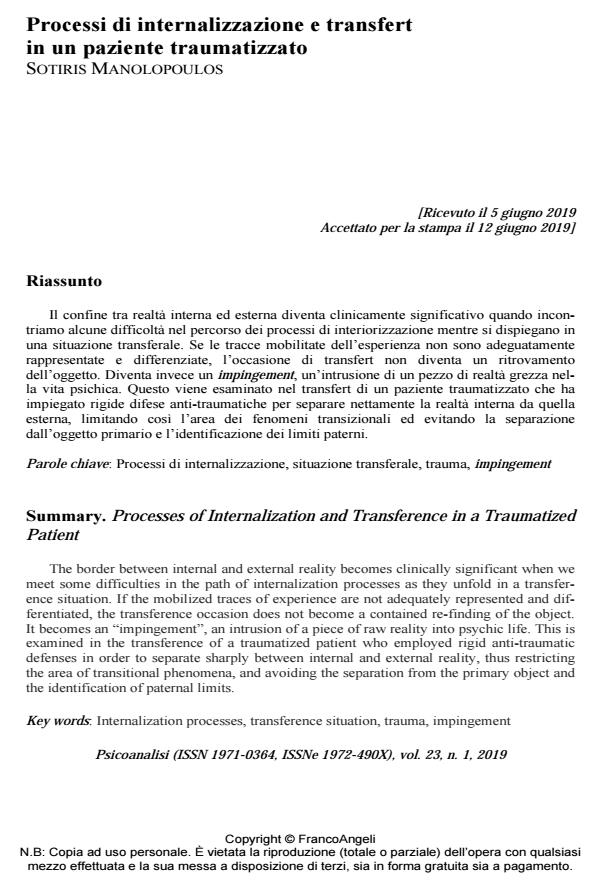Processes of Internalization and Transference in a Traumatized Patient
Journal title PSICOANALISI
Author/s Sotiris Manolopoulos
Publishing Year 2019 Issue 2019/1 Language Italian
Pages 14 P. 41-54 File size 181 KB
DOI 10.3280/PSI2019-001005
DOI is like a bar code for intellectual property: to have more infomation
click here
Below, you can see the article first page
If you want to buy this article in PDF format, you can do it, following the instructions to buy download credits

FrancoAngeli is member of Publishers International Linking Association, Inc (PILA), a not-for-profit association which run the CrossRef service enabling links to and from online scholarly content.
The border between internal and external reality becomes clinically significant when we meet some difficulties in the path of internalization processes as they unfold in a transference situation. If the mobilized traces of experience are not adequately represented and differentiat-ed, the transference occasion does not become a contained re-finding of the object. It becomes an "impingement", an intrusion of a piece of raw reality into psychic life. This is examined in the transference of a traumatized patient who employed rigid anti-traumatic defenses in order to separate sharply between internal and external reality, thus restricting the area of transitional phenomena, and avoiding the separation from the primary object and the identification of pa-ternal limits.
Keywords: Internalization processes, transference situation, trauma, impingement
- Aisenstein M. (2009). Discussion of Sander M. Abend’s “Freud, transference and therapeutic action”. Psychoanalytic Quarterly, 78: 893-901.
- Berg M. (2000). The internalizing transference. Canadian Journal of Psychoanalysis, 8, 2: 167-180.
- Bick E. (1968). The Experience of the Skin in Early Object-Relations. International Journal of Psychoanalysis, 49: 484-486.
- Bion W.R. (1965). Transformations. London: Karnac Books, 1984.
- Bleger J. (1967). Symbiosis and Ambiguity. London: Routledge, 2013.
- Bokanowski T. (2009). The splitting/trauma pairing: Ferenczi and the concept of trauma. In: Bokanowski T., Lewkowicz S. (eds), On Freud’s “Spliting of the Ego in the Process of Defence”. London: Karnac.
- Ferenczi S. (1913). Stages in the development of the sense of reality. In: First Contributions to Psychoanalysis. London: Maresfield Reprints, 1952.
- Ferenczi S. (1955). Final Contributions to the Problems and Methods of Psychoanalysis. London: Maresfield Reprints.
- Freud S. (1915a). Instincts and their vicissitudes. In: SE, 12.
- Freud S. (1915b). Observations on Tranference-love. In: SE.12.
- Freud S. (1916-1917). Introductory Lectures on Psycho-Analysis. In: SE, 15/16.
- Freud S. (1926). Inhibitions, Symptoms and Anxiety. In: SE, 20.
- Freud S. (1940). An Outline of Psychoanalysis. In: SE, 23.
- Gaddini E. (1987). Notes on the mind-body question. Int. Journal of Psychoanal., 68: 5-329.
- Green A. (2005). Key Ideas for a Contemporary Psychoanalysis. Misrecognition and Recognition of the Unconscious. London: Routledge.
- Loewald H. (1960). On the therapeutic action of psychoanalysis. Int. Journal of Psychoanal. 41: 16-33.
- Perelberg R.J. (2018). The riddle of anxiety: Between the familiar and the unfamiliar. Int. Journal of Psychoanal., 99, 4: 810-827. DOI: 10.1080/00207578.2018.1452571
- Ribas D. (2015). Genesis, primal scene, and self-engederment. In: Saragano G., Seulin C. (eds), Playing and Reality Revisited. A new Look at Wnnicott’s Classic Work. London: Karnac.
- Rosenfeld H. (1987). Impasse and interpretation: Therapeutic and Antitherapeutic Factors in the Psychoanalytic Treatment of Psychotic, Borderline, and Neurotic Patients. London: Tavistock.
- Roussillon R. (2010). The deconstruction of primary narcissism. Int. Journal of Psychoanal., 91, 4: 821-837.
- Spitz R.A., Wolf K.M. (1946). Anaclitic depression. An inquiry into the genesis of psychiatric conditions in early childhood. Psychoanalytic Study of the Child, 2: 313-342.
- Starchey J. (1934). The nature of the therapeutic action. Int. Journal of Psychoanal., 15: 127-159.
- Winnicott D.W. (1960a). The theory of parent-infant relationship. In: The maturational Process and the Facilitating Environment. London: Karnac Books, 1990.
- Winnicott D.W. (1971). Playing and Reality. London: Tavistock.
- Winnicott D.W. (1988). Human Nature. London: Free Association Press.
Sotiris Manolopoulos, Processi di internalizzazione e transfert in un paziente traumatizzato in "PSICOANALISI" 1/2019, pp 41-54, DOI: 10.3280/PSI2019-001005